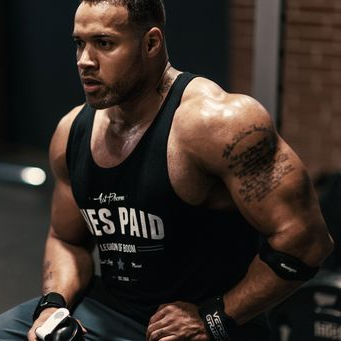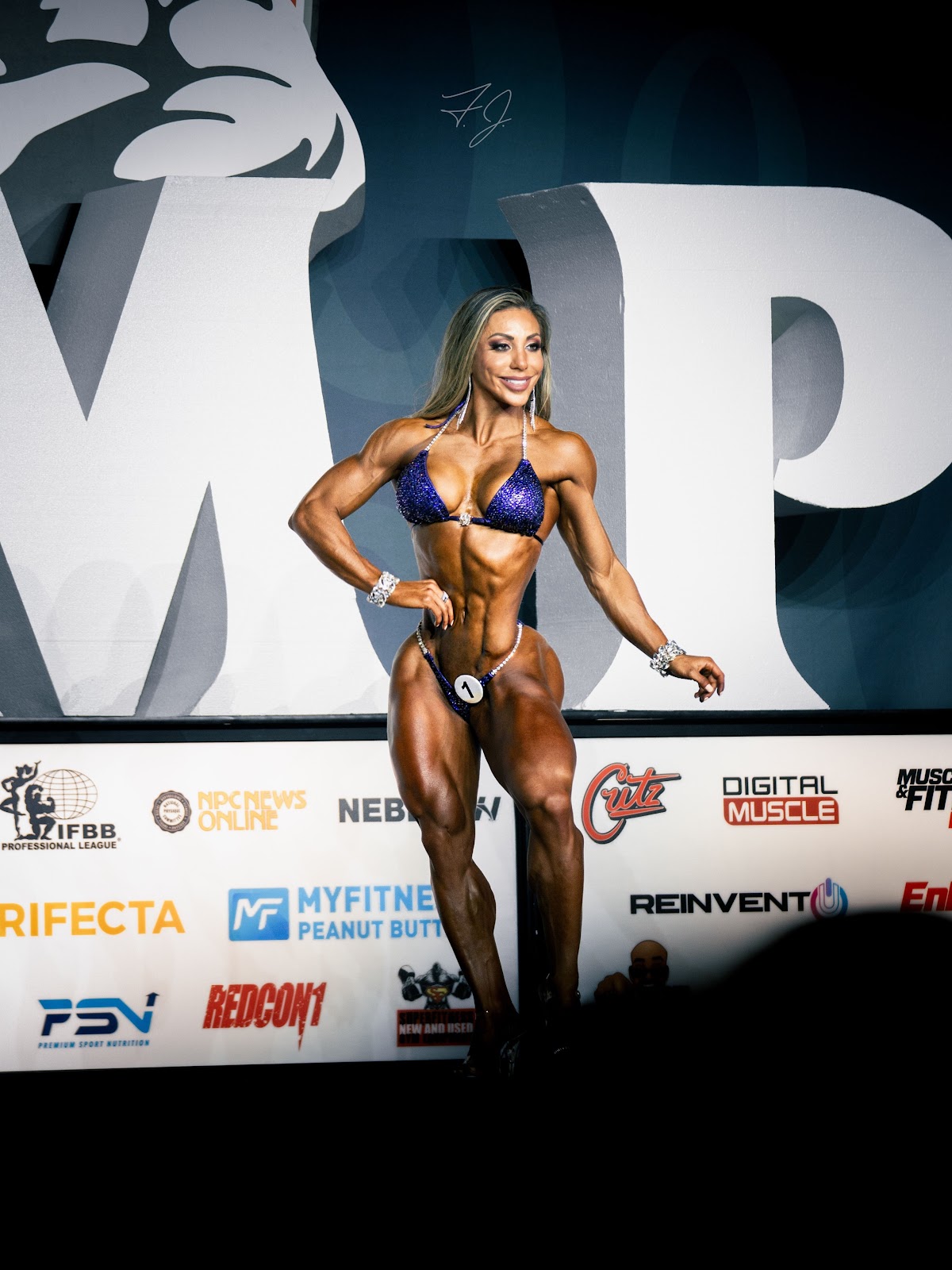Blog
Gluteal Development for Functional Performance
Advanced glute dev with workout program.
Gluteal Development for Functional Performance
Part 1, by Andre Adams
(Part 2 by Dr. Sunny Andrews is below)
Whether you’re trying to improve low back pain, fit into your pants better, or you’re a fitness competitor looking for a nice backside, optimal glute training should be an essential part of any training program.
In this blog, we will introduce you to the importance of gluteal training as it relates to functional performance as well as advanced glute training for muscular development goals.
What is glute training? Generally speaking, glute training is exercise focused around isolation of the gluteal muscles via neuromuscular activation. These muscles play a critical role in the kinematic chain by controlling hip extension and internal/lateral rotation of the hip joint. Superior (upper) fibers play a role in hip abduction whereas inferior (lower) fibers activate during hip adduction. When certain muscles of the glute complex are underactive, it can cause kinematic inefficiencies such as knee
valgus/varus, ankle rotation, low back pain and several other compensations.
Why is glute training important? Here are the top 4 reasons glute training is important to your training success:
1) Increase functional performance
2) Corrective exercise and postural alignment
a. i.e. Lordotic posture, Trendelenburg Gait correction etc.
b. Lower cross syndrome (pelvic tilt)
c. Reduce pain from biomechanical compensations
3) Kinematic chain movement efficiency & injury prevention
4) Aesthetic muscular development goals
Through proper programming and periodization, the glutes can be developed to meet the demands of specific goals. For beginners or those looking for corrective exercise, starting with stabilization-endurance movements is a great way to correct form, engage the glutes, improve joint/core stabilizers and increase work capacity for subsequent training phases. As you progress through more intense training such as strength endurance and hypertrophy training, there are several other levers you can pull to maximize effectiveness within a given phase.
1) Progressive Overloading and Specific Adaptations to Imposed Demands (S.A.I.D. Principle)
2) Variety of Exercise Selection
3) Training Intensity
4) Acute Variables
a. Reps, sets, frequency, rest intervals, timing, force, duration etc.
5) Mechanisms for Hypertrophy and Muscular Development (click link for a recent NASM-CPT/Optima podcast on this topic!)
a. Exercise-Induced Muscle Damage
b. Metabolic stress
c. Mechanical Tension (force)
d. Fascia Stretch Training
Leveraging Progressive Overloading & S.A.I.D. principle allows you to stay within a specific phase such as Muscular Development/Hypertrophy and still create muscle adaptations.
For a deep dive on these topics, check out recent blogs and eBooks to help you master these concepts:
Progressive Overloading and S.A.I.D. eBooks by Andre Adams
NASM Progressive Overloading Explained blog
Let’s take a closer look at the individual gluteal muscles and their role. In total, there are 6 hip abduction and extension muscles with the primaries being gluteus minimus/medius, gluteus maximus, and Tensor Fasciae Latae (TFL). These muscle groups work synergistically, and it is not possible to completely isolate an individual glute muscle. However, through correct exercise and variations you can place more emphasis on specific areas of the glutes.
1) Gluteus minimus (upper / outer glute development) – The glute minimus supports similar functions as its counterpart the gluteus medius. The primary role is for hip stabilization and abduction. One distinction is that this small muscle of the glutes lies deep beneath the surface on the posterior side of the hip and is generally not visible. It attaches near the surface at the ilium with the insertion points connected to the proximal end of the femur.
Common exercises: Lateral tube walking, stability ball squats with abduction, single-leg ball bridge with abduction, clamshells, single leg balance reach, side plank with hip abduction, lateral lunge.
Tips: Single leg exercises will activate your gluteus minimus by forcing hip stabilization. Also, lateral movements that require hip abduction will inherently activate this muscle.
2) Gluteus medius (upper / outer glute development) –
Overall the role and function of the gluteus medius is very similar to the gluteus minimus. For aesthetic goals, this area should be targeted to help add shape and roundness to the upper/outer glutes.
Common exercises: Lateral tube walking, stability ball squats with abduction, glute bridge with abduction, clamshells, single leg balance reach, curtsey lunges, fire hydrants, clamshells.
Tips: Single leg exercises will activate your gluteus minimus by forcing hip stabilization. Also, lateral movements that require hip abduction will inherently activate this muscle.
3) Gluteus maximus (lower glute development) – This is the largest muscle in the glute complex located in the buttocks and responsible for hip extension, lateral rotation of the hip and force production during walking/sprinting/compound exercises. Due to pattern overload such as sitting down all day, it is very common for the glute maximus to become underactive.
Common exercises: Step-ups, squats, lunges, deadlifts, RDL’s, donkey kicks, cable kickbacks, squat and leg press variations, Jefferson squat, sumo squats, standing hip extension etc.
Tips: If your hamstrings tend to take over during compound lower body movements, be sure to stretch and foam roll them first, and activate your glutes with a few light warm-up exercises before complex movements such as squats. Same goes for your low back/erector spinae and hip flexors if you have a low back arch. For muscular development, keep your training in the 70-80% range of 1RM during working sets, 3-5 sets of 6-12 reps.
How fast will I see results from glute training? In the beginning, it is not uncommon to see results in posture and overall shape relatively quickly since beginner lifters (or post physical therapy clients) are more sensitive to these step changes in training. For more advanced lifters, the results will vary depending on factors such as training intensity, frequency, nutrition, and ultimately genetics. The fact of the matter is that results take time and consistency!
Part 2, by Dr. Sunny Andrews
You can train glutes 2-6 times a week to achieve growth, however, to construct a training split that will optimize your growth you should consider several variables. If you understand each phase of the SRA curve (stimulus, recovery, and adaptation), you will better understand how long it will take you to recover. Using that information, you can optimize the timing of your subsequent training session. The stimulus is the amount of tension placed on a muscle by an exercise. The stimulus required to break down muscle depends on both the exercise and the athlete’s experience. The recovery portion of the curve is when muscle protein synthesis (MPS) predominates, and growth occurs. MPS usually lasts between 24-72 hours and is dependent on variables like nutrition, sleep, genetics, and if the muscle recovered fully from the previous training session. Adaptation is the muscle rebuilding itself to be able to withstand a greater stimulus than broke it down last time.
Studies have shown that performing approximately 15 sets of challenging glute-focused exercises a week is the optimal stimulus to increase size. However, it is best to spread those sets out throughout the week because skeletal muscles’ maximal growth stimulus is achieved after 5-6 sets of a specific exercise. This means that if you train beyond your maximal growth stimulus you will disrupt the SRA curve by delaying the recovery phase, which is counterproductive to your growth. The most important factors that contribute to determining how often you should train glutes are the specific exercises you are performing, your nutrition, and your experience level. First, we will look at different glute exercises. Exercises that cause more tension and thus cause more damage will require more time for recovery. These exercises will also stimulate the muscle to adapt in a way that will ultimately enable it to withstand more tension. For example, doing five sets of weighted triple contraction hip thrusts to failure will cause far more muscle breakdown than resistance band kickbacks. High-tension exercises, therefore, require more recovery time but cause greater adaptation. Exercises featuring an increased range of motion, more time under tension, a greater load, and a longer eccentric portion usually offer greater stimulus. Training to failure, meaning that the set ends when you cannot complete another repetition is another way to maximize stimulus.
Waiting 48 hours between training glutes is ideal, but if you are still less than 90% recovered it is best to wait another day. Muscular growth occurs during the recovery phase when muscle protein synthesis is maximized. Without sufficient nutrition, however, high-tension exercises will induce a catabolic state. If you desire muscular hypertrophy, it is best to consume a caloric surplus. This requires knowledge of your basal metabolic rate, which can be estimated through calculations on a nutrition app or website like MyNetDiary.com. The three macronutrients, protein, carbohydrates, and fats all have important roles in building muscle and can be understood with the analogy of building a house. Proteins are the structural components of the house. Carbohydrates are the construction workers whose energy allows for the assembly of these components. Fats, which contribute to the synthesis of hormones are essentially a blueprint to the house. If any of these components are lacking, your house cannot be built properly, and it will not only take much longer but might not even be built at all. Without proper nutrition, your muscles will never grow, but if you are able to optimize your nutrition, you can achieve the desired result.
When people discuss nutrient timing, they are usually discussing pre-workout, intra-workout, and post-workout meals. It is best to saturate your body with nutrients, specifically carbohydrates prior to exercising so that your muscles are full of glycogen and have the energy you need to work as hard as you can. Training fasted will never enable you to lift your personal best, preventing you from reaching your full potential. The ideal time for a pre-workout meal is usually 60-90 minutes prior to lifting. The ratio of pre-workout meal macronutrients should be carbohydrates, protein, and fats in a ratio of 15:5:2. For example, 75g of carbohydrates, 25g of protein, and 10g of fat. Intra workout meals are best consumed in liquid form to speed digestion and absorption. Only amino acids and simple carbohydrates should be consumed while training and the ideal ratio of carbohydrates to protein are approximately 5-10:2. BCAAs and Karbolyn are excellent choices for these intra-workout nutrients. Post-workout nutrients should be consumed within 30 minutes to an hour of completing your training. Post-workout meals optimally contain a 2:3:1 ratio of carbohydrates, protein, and fats.
Eating and training are clearly the most discussed topics when it comes to bodybuilding. An underappreciated topic is sleep. Without at least 8 hours of sleep a night, your body does not have time to rebuild and repair itself. If you have difficulty falling asleep try using non-stimulant pre-workout, (which is better because caffeine causes vasoconstriction limiting blood flow to your muscles) and eating a higher fat meal as your last meal. If you train your glutes every 2-3 days, time your meals correctly, and get an adequate amount of sleep so you can optimize growth. If you find yourself plateauing despite optimized nutrition, timing, and rest, a good approach is to change the exercises you use to target glutes and the frequency with which you perform them. Below is an example of a lower-body training regimen with a posterior chain emphasis.
Posterior Chain Lower Body Day:
Note: there are more than 15 sets that target your glutes here but because only the triple contraction hip thrusts and cable hip abduction / kick back super set should be to failure then this only constitutes 8 sets of your ‘challenging’ sets for the week.
Triple contraction hip thrusts on smith machine:
Sets: 4
Reps: 12-15
Rest: 90 seconds
Tempo: 1.0.1.1.1.
RPE: 80%
Form: https://www.youtube.com/watch?v=bpRpsbv7U24 (6:20 seconds will describe the form and demonstrate)
_____________________
Romanian deadlifts:
Sets: 4
Reps: 15
Rest: 60 seconds
Tempo: 3.1.2.0
RPE: 80%
Form: Slight bend in knees, there are not straight-legged deadlifts that work your hamstrings more. RDLs use your glutes more than hamstrings if your knees are slightly bent, push your hips out and up before you bend down and hinge from your waist.
_____________________
Leg press:
Sets: 4
Reps: 15
Rest: 60 seconds
Tempo: 3.2.2.0
RPE: 80-90%
Form: Feet high on the platform, push from heels, and do not totally lock out knees at the top of the exercise so you have constant tension on your glutes the entire time. Lots of time under tension here. Really embrace the burn.
_____________________
Cable abduction superset with kickbacks:
Sets: 4
Reps: 12 / 15 per leg
Rest: 30 seconds after doing both legs
Tempo: 1.1.1.1
RPE: 60%
Form: Proper form is so important here; you are only moving your leg from your hip and no other part of your body. If the weight is too heavy to do this, you’re using too much weight. When you do cable abduction, there should be a slight bend in your knee and your leg goes out to your side. When you do kickbacks try and have your toe pointed to the ground if you can, but this will depend on your hip flexibility and your alignment.
_____________________
Seated abduction:
Sets: 4 (4th set is a drop set)
Reps: 15
Rest: 60 seconds
Tempo: 2.0.2.0
RPE: 90%
Form: sit on the edge of the seat and sit up straight
_____________________
Glute bridges with a dumbbell with soles facing one another:
Sets: 4
Reps: 50
Rest: 60
Tempo: 1.1.1.1
RPE: 50%
Form: Lay on the ground, put a dumbbell on your hip bones, your legs should form a diamond shape with soles of your feet together. Some refer to this variation as ‘froggy pumps’.
_____________________
About the Authors
Andre Adams:

Andre Adams is a professional athlete with the International Federation of Bodybuilding (IFBB) pro league, having competed in the 2015 Mr. Olympia and Arnold Classic professional physique divisions.
He is also a Master Trainer with the National Academy of Sports Medicine® (NASM), physique contest prep coach, and holds several specializations with NASM. Certifications include: NASM-CPT, WFS, PES, WLS, GPTS, FNS and MT.
Instagram: @AndreAdams_Official
Health & Performance Supplements: www.1stphorm.com/AndreAdams
Website: www.andreadamsofficial.com
Dr. Sunny Andrews:

I was a competitive athlete from a young age and had dreams of being a professional soccer player or running track in the Olympics. Those goals changed when I decided to focus on academics and pursue a career as a medical doctor. I moved to the Caribbean to start medical school and did not have time to complete my daily 10-15 mile run anymore. I assimilated to the Caribbean culture and began catching my food by spearfishing and began lifting weights before or after class. I loved how confident and happy the women in the Caribbean were and I wanted to embrace as much of the culture as I could and bring it back to the USA with me. When I returned after almost 3 years I felt like a different person, mentally and physically. I decided to dedicate my life to being a physician and fitness coach that focuses on wellness and preventative medicine.
Instagram: @drsunnyandrews
Website: https://onsznfitness.com/


1 Comment
Suggestions
Useful article. Most people think Glute workouts are for women but men need them too. It’d be useful if the suggested workout could be exported to FitBod app on iPhone.
David M Dimston, 01/19/2022 15:18:42